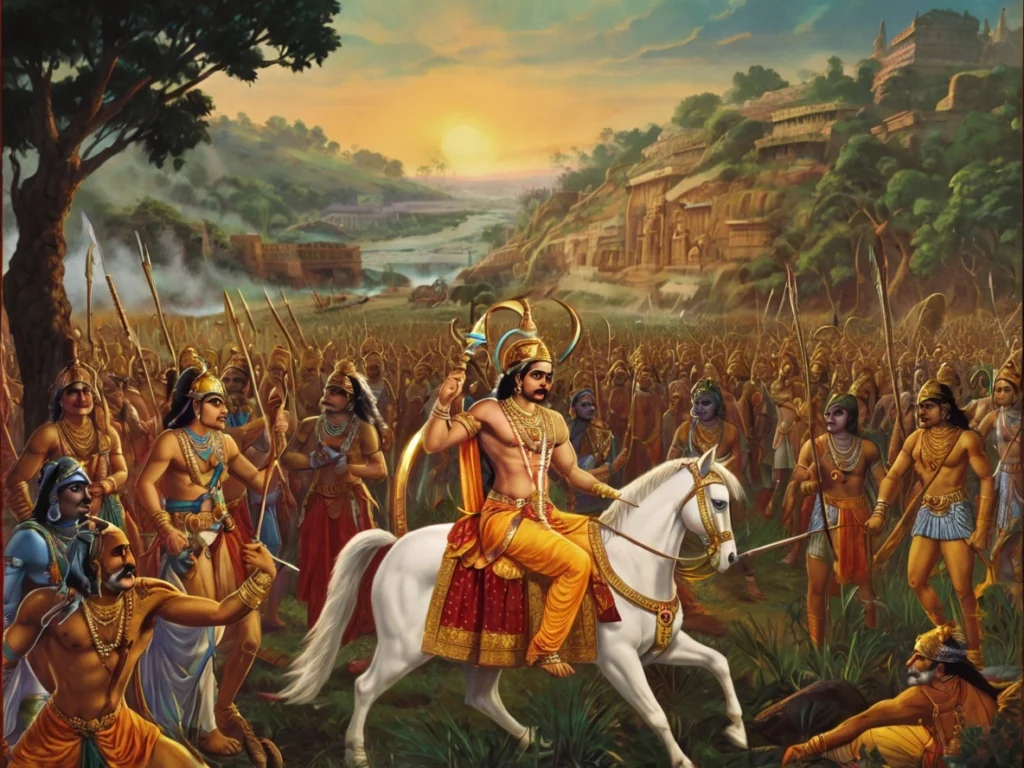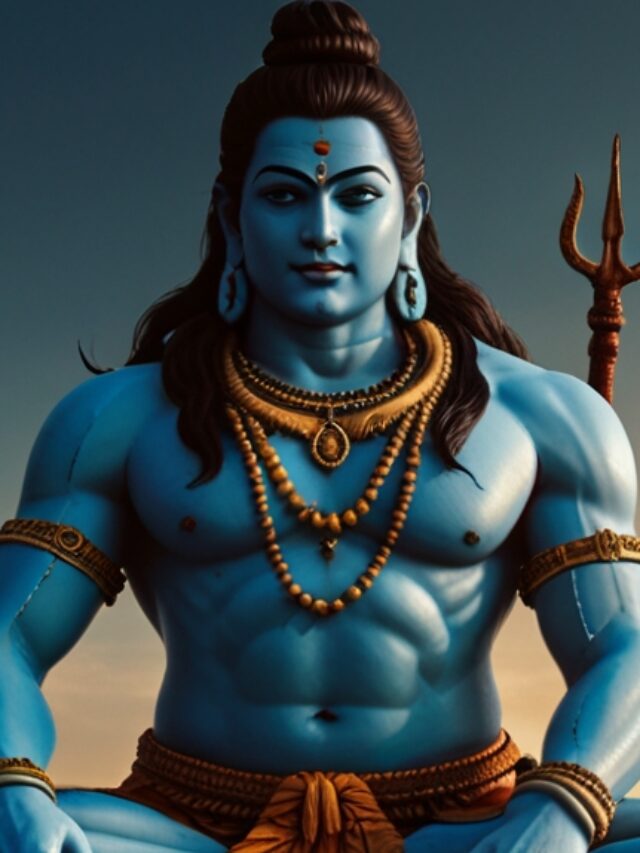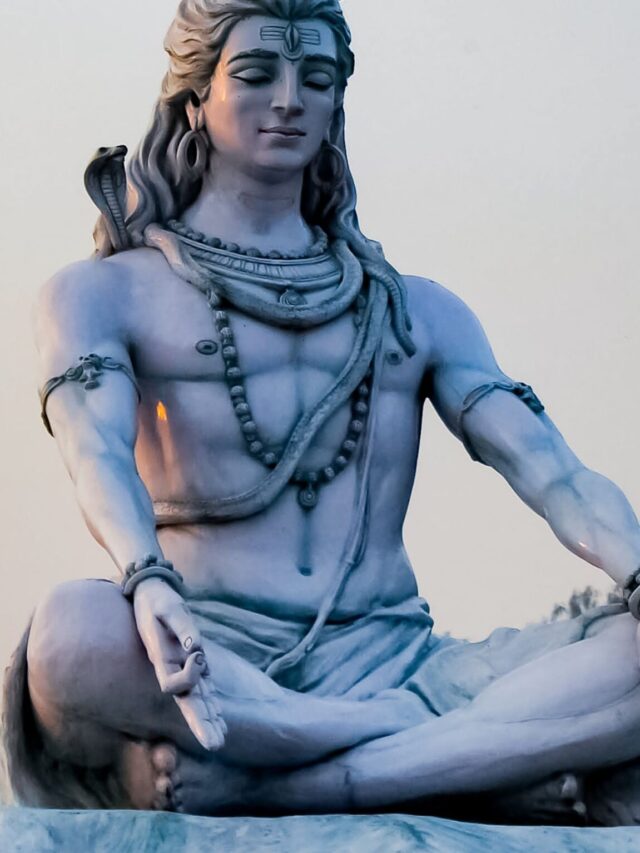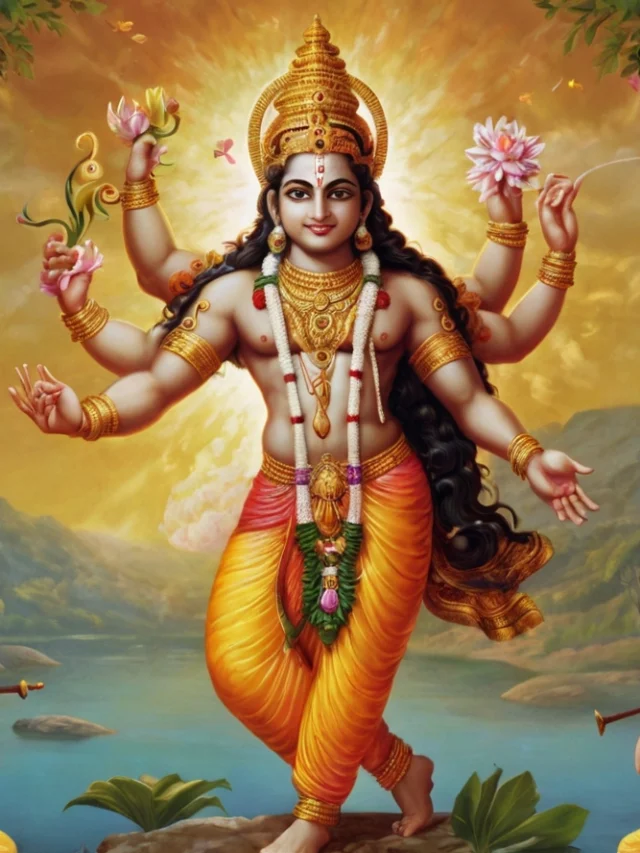Day 2 of the Mahabharata: The Fierce Battle and King Virata’s Vengeance. Explore the intense events of Day 2 of the Mahabharata, where the battle rages on with Bhishma’s onslaught and King Virata’s furious charge to avenge his sons, showcasing epic duels, heroic stands, and the relentless pursuit of justice.

Day 2 of the Kurukshetra War in the Mahabharata
On the second day of the Kurukshetra War, the battle resumed with renewed vigor from both sides. The Kauravas, led by Bhishma, sought to avenge the losses they suffered on the first day. Meanwhile, the Pandavas were equally determined to maintain their momentum and gain an upper hand.
Key Events of Day 2:
Morning Battle: As the sun rose, the two armies formed their battle lines again. Bhishma, the Kaurava commander, led the Kauravas from the front with his mighty bow, unleashing volleys of arrows that caused heavy casualties among the Pandava ranks. Arjuna, the chief warrior of the Pandavas, countered Bhishma’s attacks, but Bhishma’s prowess made it difficult for the Pandavas to advance.
Bhima’s Fury: Bhima, one of the Pandava brothers known for his immense strength and fierce temper, was enraged by the sight of the fallen Pandava soldiers. He charged toward the Kaurava army with his mace, smashing through enemy chariots, horses, and soldiers with terrifying force. Bhima was unstoppable and created havoc among the Kauravas, challenging Duryodhana and other warriors to face him.
Duryodhana’s Strategy: Duryodhana, the Kaurava prince, was deeply concerned by Bhima’s advance. He sought out his friend and formidable warrior, Karna, who had not yet joined the battle due to his vow of not fighting under Bhishma’s command. Karna assured Duryodhana that he would soon enter the battlefield and bring great damage to the Pandavas once Bhishma was no longer the commander.
Duels and Skirmishes: The second day also saw many individual duels between the great warriors on both sides. Abhimanyu, the son of Arjuna, displayed exceptional courage and skills on the battlefield, holding his own against many Kaurava warriors. Dronacharya, the Kauravas’ great teacher, fought ferociously, causing significant losses to the Pandava army.
Bhishma’s Onslaught: Bhishma, realizing that he needed to change his tactics to break the spirit of the Pandavas, intensified his attacks. His presence on the battlefield was akin to a raging fire, and he inflicted severe damage on the Pandava forces. His unparalleled skill and knowledge of warfare made it difficult for the Pandavas to sustain their morale.
Krishna’s Counsel: At a critical moment in the battle, Krishna, serving as Arjuna’s charioteer, counseled Arjuna to be more aggressive against Bhishma. Arjuna was initially hesitant due to his respect for Bhishma, who was also his great-grandfather. However, Krishna reminded him of his duty as a warrior and the righteousness of their cause. Encouraged by Krishna’s words, Arjuna intensified his attacks.
End of Day Two: As the day progressed, both sides suffered heavy losses. Eventually, the sun began to set, signaling the end of the day’s fighting. The armies retreated to their respective camps to rest and regroup. The Kauravas, despite inflicting significant damage, were unable to decisively defeat the Pandavas. Both sides realized that the war would be long and arduous.
The Second Day Of The Battle, King Virata Of Matsya, An Ally Of The Pandavas
On the second day of the battle, King Virata of Matsya, an ally of the Pandavas, was overcome with grief and fury after learning of the death of his sons, Uttara and Shveta, at the hands of the Kauravas. The loss of his beloved sons filled him with a renewed rage, and he decided to take matters into his own hands to avenge their deaths.
Virata’s Charge with Fury
With his heart burning with anger and a thirst for revenge, King Virata donned his armor and mounted his chariot. His eyes were red with fury, and his face was set in a grim expression of determination. Virata took up his bow, ready to unleash his wrath upon the Kaurava forces. He commanded his charioteer to drive straight into the thick of the battle where the enemies were most concentrated.
As Virata charged into the battlefield, he let out a fierce war cry, catching the attention of both the Pandavas and the Kauravas. He rode like a tempest, his arrows flying with deadly accuracy and speed, striking down numerous Kaurava warriors, charioteers, and soldiers in his path. His wrath was like that of a lion who had lost its cubs, and no one could stand against his fury.
Encounter with Bhishma and Drona
Seeing Virata advancing with such determination, Bhishma, the commander of the Kaurava forces, realized the danger he posed. Bhishma moved swiftly to intercept Virata, firing a rain of arrows to halt his charge. But Virata, driven by his rage, skillfully dodged Bhishma’s attacks and continued his assault. He retaliated by firing several arrows at Bhishma, forcing the grand elder to momentarily step back.
Dronacharya, another stalwart of the Kaurava army, also joined the fight against Virata. Drona, known for his unmatched archery skills and strategic mind, launched a series of arrows that targeted Virata’s charioteer and horses, attempting to incapacitate his chariot. However, Virata’s anger made him fight with unrelenting force, and he managed to break Drona’s attack, wounding several of Drona’s supporters in the process.
Unleashing Devastation
Virata’s assault was relentless; he rode through the Kaurava ranks like a storm, cutting down anyone who dared to come near him. His arrows flew with the force of thunderbolts, and his swordsmanship was unmatched. His fury knew no bounds, and he fought like a man possessed, driven by the desire to avenge his sons.
He confronted many of the Kaurava warriors in single combat, striking down those who dared to face him. The Kauravas, witnessing his ferocity, were momentarily taken aback. Even the mighty Bhishma and Drona found it challenging to contain Virata’s fury, as he fought with the strength and intensity of a hundred warriors.
Turning the Tide
Virata’s charge brought new life to the Pandava forces, who were inspired by his courage and determination. The Pandava warriors, seeing Virata’s fierce onslaught, renewed their efforts and began to push back against the Kauravas. However, Virata’s rage-driven attack also drew the attention of other great warriors of the Kaurava side.
The Heroism and the Ultimate Fate
Despite his bravery and the terror he unleashed upon the Kaurava soldiers, Virata soon found himself surrounded by several mighty Kaurava warriors. They unleashed a concentrated assault on him from all sides. Though he fought valiantly, his chariot was eventually shattered, and his horses were slain.
Virata, however, did not relent. He continued to fight on foot, wielding his sword with fierce determination, cutting down any who approached him. But, ultimately, the combined strength of the Kaurava warriors overwhelmed him. Fatigued and outnumbered, King Virata fell in battle, but not before taking a significant toll on the Kaurava forces.
A Noble Warrior Remembered
King Virata’s heroic stand became a symbol of courage and determination. His valor inspired the Pandavas and their allies, reminding them of the sacrifices they were making in the pursuit of justice. Though Virata perished, his name was honored by the Pandavas and became a lasting testament to a king who fought valiantly to avenge his sons and uphold dharma.

Who Was Virata?
Virata was the king of the Matsya Kingdom, a prominent and valorous ruler in the epic Mahabharata. Known for his bravery, wisdom, and strong sense of justice, Virata played a significant role during the period when the Pandavas were in exile and during the Kurukshetra War.
Background and Kingdom
Virata ruled over the Matsya Kingdom, with its capital in the city of Upaplavya. The Matsya Kingdom was situated in the northwestern part of ancient India, near the modern-day Rajasthan region. It was a prosperous and strategically significant kingdom known for its wealth, powerful army, and skilled warriors.
Association with the Pandavas
During the Pandavas’ thirteen-year exile, the last year was to be spent in incognito, hidden from the Kauravas’ spies. The Pandavas chose to spend this year in disguise in the court of King Virata, hiding their true identities:
- Yudhishthira became Kanka, an advisor to Virata.
- Bhima took the role of Vallabha, the royal cook and wrestler.
- Arjuna, disguised as Brihannala, served as a dance teacher to Virata’s daughter, Uttaraa.
- Nakula became Granthika, a keeper of horses, and
- Sahadeva became Tantripala, a keeper of cattle.
- Draupadi took on the identity of Sairandhri, the queen Sudeshna’s maid.
Virata, unaware of their true identities, welcomed them into his court, impressed by their skills and abilities. During their stay, the Pandavas gained his favor and respect.
The Cattle Raid and Virata’s Role
Toward the end of the incognito period, the Kauravas, led by Duryodhana, attempted to steal the cattle of the Matsya Kingdom. This led to the Battle of Virata, in which the Pandavas came out of hiding to defend Virata’s kingdom.
- Arjuna, in his guise as Brihannala, took charge and single-handedly defeated the Kaurava forces, including the great warriors Bhishma, Dronacharya, Karna, and others.
- King Virata was initially unaware that his son, Uttara, who had gone into battle with Arjuna as his charioteer, was fighting under the protection of one of the Pandavas.
After the battle, Virata realized the true identity of the Pandavas. Grateful for their help and impressed by their valor, he became a firm ally of the Pandavas. To cement this alliance, Virata offered his daughter, Uttaraa, in marriage to Arjuna. However, Arjuna, considering himself her teacher, suggested that she marry his son, Abhimanyu, instead, which led to a significant alliance between the Matsyas and the Pandavas.
Role in the Kurukshetra War
During the Kurukshetra War, Virata, along with his sons, sided with the Pandavas. He fought valiantly on their side, contributing his forces and resources to the cause of dharma (righteousness). His sons, Uttara and Shveta, were also significant warriors in the war.
- On the first day of the battle, Shveta fought bravely but was killed by Bhishma, causing deep grief to Virata.
- On the second day, his son Uttara was also killed by Shalya, further fueling Virata’s rage and desire for vengeance.
Virata, filled with anger and grief over the loss of his sons, fought fiercely against the Kauravas. Despite his age, he displayed great valor, charging into the enemy ranks and taking on many formidable warriors, including Bhishma and Dronacharya. Eventually, he fell in battle, but his bravery and dedication to the Pandavas’ cause were widely respected.
Legacy
King Virata is remembered as a noble and just ruler who stood by righteousness and justice. He is honored for providing shelter to the Pandavas during their exile and for his unwavering support during the great war of Kurukshetra. His legacy as a courageous warrior and a wise king is celebrated in the epic, symbolizing the virtues of loyalty, friendship, and honor.



